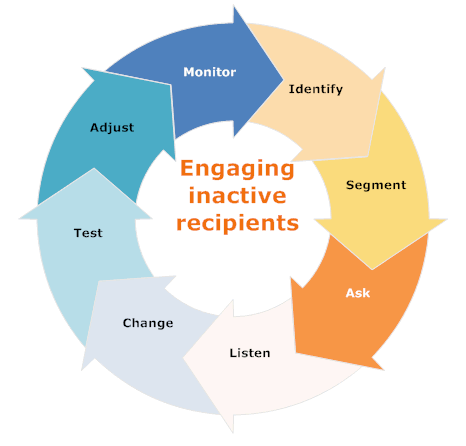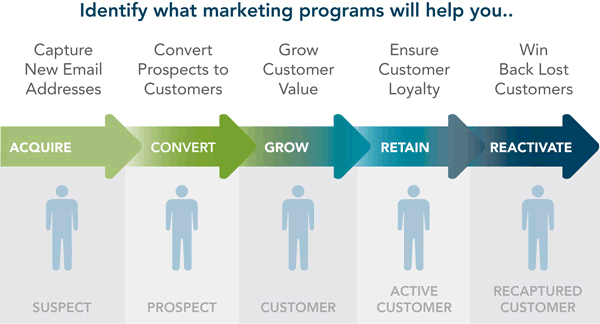We all have them: inactive subscribers to our email marketing program and dormant email addresses. People that are still subscribed to our email lists with a valid email address but never open their emails, let alone interact with them.
How do you reactivate and re-engage these inactive email subscribers? Well, obviously, it starts by defining what an inactive email subscriber is. The best way to do that is tracking your metrics (opens and clicks) over a certain period of time and then simply looking at the recipients that didn’t open their emails. Of course you can define other rules such as recipients that opened one mail out of ten but never once clicked.
The next thing to do is understanding why the email addresses of these recipients simply are sleeping in your email database. There can be several reasons.
Maybe the email address is dormant. Think about webmail addresses that have been created once but are not used anymore (or very rarely). Another reason can be that the subscriber is not interested anymore. Or maybe he thinks the value of your emails is not what it used to be. You can find dozens of other possible reasons. However, let’s assume in this post that the email address is not dormant and look at some steps and tips to re-engage the uninterested and inactive. I’ve divided this process in a few steps as you can see in the image below.

Step 1: Identify inactive email recipients
This is what I just briefly explained, but of course it’s important that you think about this carefully. What is an inactive recipient for you and how do you identify him?
This step isn’t too hard. Analyze the metrics you picked, export them in a spreadsheet (or use the tools your email marketing platform offers) and do the math. Of course, you should not confuse the email addresses of inactive recipients with hard bounces.
Step 2: Segment your inactive recipients
We all know what segmentation is: dividing our email recipients in all kinds of segments, based on various parameters, in order to offer them a more personal email experience (and at the same time improve deliverability and conversion).
Why don’t you use the same for your inactive recipients? You can check the demographics and other data you have about them. Maybe you’ll discover that a large percentage of inactive recipients has something in common. Of course this will depend from the quality of your list. You might, for instance, discover that many inactive recipients have signed up for your email when subscribing for a webinar about a specific topic (that you since didn’t cover anymore, you know what to do…).
Step 3: Ask inactive email subscribers why they are inactive
Obviously, inactive recipients will not massively answer to queries about what they want in your email if they don’t open your emails in the first place. However, a more personal mail from a person they know, might do wonders. In order to understand why people don’t open your emails, you simply ask them. If the percentage of respondents is low, which it probably will be, you can contact subscribers via other media.
Here also the quality of your list (meaning the data you have gathered via various email and other ‘touch points) is crucial. If you don’t have a company name and name, it’s hard to give people a call. When you have a large list, obviously you won’t call everyone but if you segment your inactive recipients, you might contact a representative number of them for a survey.

Step 4: Listen
Listen to the data and patterns you have discovered in steps 2 and 3. But most of all, listen to the input you got from inactive recipients that could be reached and took the trouble to answer.
Listening alone is the beginning of analyzing, understanding and responding. You will soon discover why people don’t open your emails and know if it’s a matter of frequency, content, format, perceived value, lack of personalization and/or maybe the fact that some subscribers want to keep in touch with you via other channels. Times are changing and the utilization of communication channels as well, remember.
Step 5: Change
When you know what recipients and recipient segments want, it’s a matter of deciding on what should be changed. You will probably not receive one answer that solves all your problems. People fortunately are different and the reasons why they don’t open your emails anymore, will vary.
Analyze the cost and benefits of certain changes and then implement them. Some changes might be simple. If your content is not relevant enough, then improve it. Others will be harder and might require an investment. You might need some new tools if you find out that recipients want highly personalized emails, this might also require the creation of additional content. There is a cost attached to all this, do the math.
I guess you will not do a large investment to solve an issue that has been brought up by 1% of all inactive recipients. ROI, right?
Step 6: Testing
There is a difference between what people say they want, and what they do when they get it. You might have done all changes and still find that a percentage of the recipients that were inactive…remain inactive. Maybe the changes will not be good enough or maybe people gave an answer to your questions in good faith but in fact simply are not interested anymore. A nice little incentive and some buzz about your changes might be a good idea.
You will normally also not be able to reach out to all inactive subscribers. So, it’s back to good old testing anyway. Try out other content, headlines, subject lines, offers, frequencies, formats, whatever. Test several things step-by-step and analyze the effects. Even if all this improving and testing doesn’t re-engage the majority of your inactive recipients, realize that testing and increasing the value and relevancy of your emails also serves another purpose: improving your email relationships with active recipients….
Step 7: Adjust
You don’t change everything in one day. It might even scare off active subscribers. Of course, you can only change things for inactive recipients but why leave out active subscribers of positive change?
However, take it step by step. Normally, when you test emails, whatever method you use, you assess the impact of every little change (unless you have the most sophisticated multivariate testing methods that exist maybe, and then again).
Test and adjust, analyze, adjust more and test again, etc. You know how it works.
Step 8: Monitor
Reality is dynamic. New communication channels come (and sometimes go), the needs of people change, everything changes.
Looking at the (in-)activity is not a one-time exercise, it’s something that should be done regularly. In fact, when monitoring activity and performing all the steps repeatedly, you will probably pro-actively avoid having too much inactive recipients in the future.
Monitor, analyze, ask, listen, enrich your database, segment, identify and test, test, test,….
Email activity and the lifecycle context
Most email programs today are based on triggers, events, customer lifecycle stages, etc. Or in other words: the classic batch and often ad hoc approach of email marketing is less prominent than it used to be. In order to reactivate subscribers – or let’s say contacts – and even gain back unsubscribes, look at the different lifecycle stages and flows in which you lose attention and responsiveness as well. In automated mails in specific processes such as online buying, you should of course also look at things such as abandoned shopping carts but that goes beyond the scope of the topic of this page.

